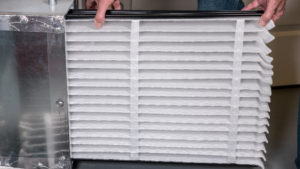 Furnaces cycle air constantly through your home. In the process, they draw in dirt, pollen, and other debris that can damage its internal components. At the same time, hair, pollen, and dust are sucked in through grates as cool air is returned to the heat exchanger. Filters catch these stray particles, significantly improving air quality.
Furnaces cycle air constantly through your home. In the process, they draw in dirt, pollen, and other debris that can damage its internal components. At the same time, hair, pollen, and dust are sucked in through grates as cool air is returned to the heat exchanger. Filters catch these stray particles, significantly improving air quality.
However, as particulate matter accumulates over time, filters can become clogged, lowering air quality and hindering the operation of your heating system. Replacing the filter is essential not only for clean air, but for efficient heating. Regularly replacing filters can even extend the life of your furnace. For any homeowner interested in optimizing their HVAC system, here is a short guide on how to replace a furnace filter.
When to Replace a Furnace Filter
Like furnaces, filters vary in size. Thicker filters have more surface area, which allows them to trap a greater number of particles without hindering airflow. Depending on the size of your filter, it needs to be replaced every:
- 3 Months (Filters 1-2 Inches Thick)
- 6-9 Months (Filters 3-4 Inches Thick)
- 9-12 Months (Filters 5-6 Inches Thick)
These time frames may differ depending on where you live. Because people rely on their furnaces most during winter, homeowners in cold climates may have to change their filters more often. People living with pets, in dusty environments, or near major roadways may also find their filters clog faster than usual. Signs your filter needs to be replaced include:
- Reduced Air Flow. Clogged filters prevent air from moving freely through your heating system.
- Dust. When filters become oversaturated, dust particles can break off and get blown through your vents.
- Unpleasant Odors. If particles are allowed to build up inside a filter, they can become overheated and emit an acrid, burning smell.
- Higher Heating Bills. The more matter filters absorb, the more difficult it is to circulate air through your home. As a result, homes with clogged filters see their heating bills spike as the furnace has to run harder and longer to maintain a comfortable temperature.
Furnace filters contain no hazardous or toxic materials, so once you’re done, dispose of them with the rest of your household trash.
How to Replace a Furnace Filter
Replacing a furnace filter is a straightforward task that requires no special tools or training. All that’s needed is fifteen minutes and the correct filter. Check with your manufacturer to see which filter size is compatible with their system. A filter that’s too thin won’t be effective at trapping particles, while a filter that’s too thick will obstruct air flow. Once you’ve purchased the right replacement, the rest of the process is simple.
- Shut down your furnace
- Open the service panel, generally located on the side or top of your furnace
- Slide the old filter out
- Slide the new filter in
- Shut the service panel
- Restart the furnace
Protect Your Furnace
Replacing your furnace filter reduces the strain on your heating system, but can’t eliminate it. Furnaces experience a great deal of wear and tear over their lifetime, but especially during winter. Worn parts can lead to breakdowns that leave you stranded without heat. Home insurance doesn’t cover this type of damage, but we will.
Agway’s EnergyGuardTM program protects your heating, cooling, and electric lines*. If the need for repair occurs, our service team sends a technician to your house and pays for all covered parts. There are no service fees or deductibles. Contact us today to start saving!
*Coverage depends on which commodity you purchase.